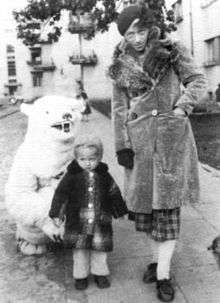Katarzyna Kobro
| Katarzyna Kobro | |
|---|---|
 | |
| Born |
26 November 1898 Moscow, Russian Empire |
| Died |
21 February 1951 (aged 52) Łódź, Poland |
| Nationality | Polish |
| Education | Moscow School of Painting, Sculpture and Architecture |
| Known for | Sculpture |
| Movement | Constructivism |
| Spouse(s) |
Władysław Strzemiński (m. 1920) ending in divorce |
Katarzyna Kobro (26 January 1898 in Moscow – 21 February 1951[1] in Łódź) was a Polish sculptor.
Her father came from a family of Latvian Germans and her mother was Russian.[1] She spent her early years in Riga, then moved with her family to Moscow in 1915. From 1917 to 1920 she studied at the Moscow School of Painting, Sculpture and Architecture.[2] She was a member of the Moscow Union of Artists with Casimir Malevich, Olga Rozanova, Vladimir Tatlin and Alexander Rodchenko, among others.
In 1920 Kobro married Polish artist Władysław Strzemiński[1] (1893-1952). In the beginning of 1922, she fled to Poland and in 1924 obtained Polish citizenship.
The couple established themselves in Szczekociny, but later lived near Łódź, in Brzeziny and Koluszki, where they worked as teachers.[1] In 1926 Kobro co-founded the Praesens group with architects Bohdan Lachert and Szymon Syrkus, but left the group in 1929 over content differences. Kobro, Strzemiński, painter Henryk Stażewski and poets Jan Brzękowski and Julian Przyboś then founded a.r. group, an acronym that is usually interpreted as "Revolutionary Artists" or "Real Avant-Garde". She was instrumental in the establishment of the Museum of Modern Art in Łódź. In 1932, she and her husband joined the Abstraction-Création group. In 1937 Kobro signed the 1936 Dimensionist Manifesto published by Jean Arp, Marcel Duchamp and László Moholy-Nagy.
Under the influence of Constructivism she rejected individualism, subjectivism and expressionism, and instead postulated the absolute objectivism of form. Her main aim was to build an abstract work of art, based on universal and objective rules discovered through experimentation and analysis. Her sculpture conceptualized infinite space, which was to be seen as uniform and without focal or reference points (such as the origin of a coordinate system). Therefore, she strove to organize space in such a way that it would not be divided into space enclosed within form and excluded from it, but instead for the work to coexist with space and to allow space to penetrate it.
References
External links
- Katarzyna Kobro at culture.pl
- Information on Works
- Overview of life and work at ddg.art.pl
- Biographical article on Jstor
- International Collection of Modern Art of the “a.r.” group
| Wikimedia Commons has media related to Katarzyna Kobro. |